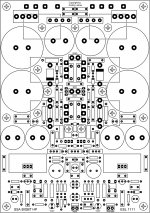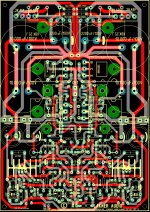as per the 3U 133mm rack size standard, modushop appear to measure their entire box brutto height, and thus internal height is only 120mm
but doesnt matter when there is a 4U 😉
Now you know why PCB is 120 mm, notoriously standard dimension in pro-audio. 😀
ARGGGG double side pcb board....a pity to etch at house....so it seems that i need to spend many time on eagle for sigle side way.... with more room needed. LC i suppose that BIGBT HP in lowaer rail voltage count same parts number as your hightest version...only value changing inside????
Marc
Note : NJL4302DG arrived today so yet i have 5 couples NJL4281DG/4302DG for SSA_TT_35V
I am sorry for that my PCB version is inappropriate for you, but it is mine version and suited strictly to my needs and expectations. Schematic of it was published, so anyone can design a PCB exactly to his own taste, you're welcome too.
Yes, only the values will be recalculated later on. 😉
It is only a suggestion. Move the el-caps a bit away and place polyprop caps close instead.
... place polyprop caps close instead.

Cannot do closer than 3 mm from rails split to the outputs. 😎
El-caps does not go higher than a few hundred kilohertz. The film caps stretches to around a few megahertz.
mhhmm ... I wonder mhmm ... and mica to few hundreds ... mhmmm thanks anyway

Member
Joined 2009
Paid Member
It is only a suggestion. Move the el-caps a bit away and place polyprop caps close instead.
El-caps does not go higher than a few hundred kilohertz. The film caps stretches to around a few megahertz.
Hugh found same thing on one of his amplifiers.
The big electro's can be some distance away. In my first amplifier I placed them all in the chasis and none on the amplifier board. With short distance wiring this works just fine. It keeps them away from the heat of the power devices too not to mention less mechanical stress if they aren't hanging sideways off a board.
I am sorry for that my PCB version is inappropriate for you, but it is mine version and suited strictly to my needs and expectations. Schematic of it was published, so anyone can design a PCB exactly to his own taste, you're welcome too.
Yes, only the values will be recalculated later on. 😉
Don't be sorry. The value recalculation to my 50/60V rail is more than i can askinng from you. As i am not able on electronic amp design....pcb board making, internal and external architecture/design is the way i made a DIY project mine. Than if some provide a fonctionnal schematic with my requierement i am more than happy.
Marc
Edit : I just look what sort of standart Pcb board are available and could match with the goal. There is a 150x200mm; i will try to do with this.
Last edited:
hey, looking great
hmm, I wonder if it also would be a good realiable bassguitar power amp
why 100V caps ?
hmm, I wonder if it also would be a good realiable bassguitar power amp
why 100V caps ?
hey, looking great
hmm, I wonder if it also would be a good realiable bassguitar power amp
why 100V caps ?
It could be very fine bassguitar amp driving bass cone directly (active filter), freq response is from DC up to MHz 🙂
I prepare the space for 80 V elcos, this is only typo, because 100 V has bigger diameter.
Why 80 V elcos? Well this amp is intended to be also 100 W/20 ohm (my horn drivers impedance) so there you need higher supply voltage to get this power on ohm (+/- 70 V rails potential).
Andrej, what will be the 8 Ohm RMS power?
It can deliver 200 W/8 ohm (56,56 Vp) at +/- 63 V rails potential at least in theory, but with only two pairs of outputs it is more real to be 150 W/8 ohm (48,99 Vp) with some dynamic headroom. I suggest that 150 W is correct number to put in a equation to calculate the right size of the heatsink. 😉
..... PCB ready, size 170 mm X 120 mm , but not symetrical layout 🙂
Alex.
Hehehe Alex I knew you will made it. Very nice layout very similar to mine expectations. At this point it is the best solution for this kind of SSA version.
Regarding my PCB design I can tell you that after some years in a garage my "PCB train" already left the station and the trains are very hard to stop when started ...

Any chance to listen this beast? 😱
Yes, no problem, when and if it will be ready.

as an experienced project manager of instrumentation design (medical), I believe it is important, at some stage, to 'freeze' the design process, and build the thing. I think this is the time for this design. Bit of advice, don't make too many big steps!!!
It seems to have evolved from a very interesting, simple and innovative design into a monster.
regards
Bryan
ref nichrome et al as power resistors: I believe that wirewound resistors use nichrome and constantin wire, and have done so for a considerable time.
It seems to have evolved from a very interesting, simple and innovative design into a monster.
regards
Bryan
ref nichrome et al as power resistors: I believe that wirewound resistors use nichrome and constantin wire, and have done so for a considerable time.
Last edited:
Where do you see a monster ? Just a dressed simple symmetrical amplifier instead of a naked one ;-)It seems to have evolved from a very interesting, simple and innovative design into a monster.
I believe it is important, at some stage, to 'freeze' the design process, and build the thing. I think this is the time for this design. Bit of advice, don't make too many big steps!!!
It seems to have evolved from a very interesting, simple and innovative design into a monster.
Yeah so it seems. And I still have a doubt on the IGBT output stage. It is not yet "proven". Usually is good on first impression. But for long time enjoyment, I'm not convinced. Visually I still prefer the TGM5 with its proven output stage. But I'm still faithfully waiting for high performance version of lateral FET SSA 😀
@cat squirrel
SSA evolved from simple nice sounding amp to a normal 16 BJT-s per channel unit. I see it more like universal now than monsterous creature. Mine quest is freezed for now with SSA BIGBT HP.
@Jay
If anything here is 100% tested than it would be BIGBT. I will publish some pics of my amp called StereoLith from 2003, where I implemented BIGBT-s in a large scale. It works perfectly since the day it was born.
SSA evolved from simple nice sounding amp to a normal 16 BJT-s per channel unit. I see it more like universal now than monsterous creature. Mine quest is freezed for now with SSA BIGBT HP.

@Jay
If anything here is 100% tested than it would be BIGBT. I will publish some pics of my amp called StereoLith from 2003, where I implemented BIGBT-s in a large scale. It works perfectly since the day it was born.

Lazycat
the big attraction for me was the simplicity and low transistor count/cost, and that a pcb may be forthcoming. Obviously something a beginner could make without too much effort and cash outlay. The fact that the design can be used to fulfill many people's needs/wants is testament to a good design, but it would have been nice to start out with the simple design, tested, before going for a full blown monster.
To me, as a simple music lover, I like so many things about your design, and will only need a little change to fit my ideas of a medium power monobloc, and I may post these in time, but I am in the middle of moving house at the moment, and I haven't the time.
To me, a good design is 93-95% there, first time around (however that can be measured) and I believe your design is within this philosophy.

Bryan
the big attraction for me was the simplicity and low transistor count/cost, and that a pcb may be forthcoming. Obviously something a beginner could make without too much effort and cash outlay. The fact that the design can be used to fulfill many people's needs/wants is testament to a good design, but it would have been nice to start out with the simple design, tested, before going for a full blown monster.
To me, as a simple music lover, I like so many things about your design, and will only need a little change to fit my ideas of a medium power monobloc, and I may post these in time, but I am in the middle of moving house at the moment, and I haven't the time.
To me, a good design is 93-95% there, first time around (however that can be measured) and I believe your design is within this philosophy.

Bryan
- Status
- Not open for further replies.
- Home
- Amplifiers
- Solid State
- Simple Symetrical Amplifier


